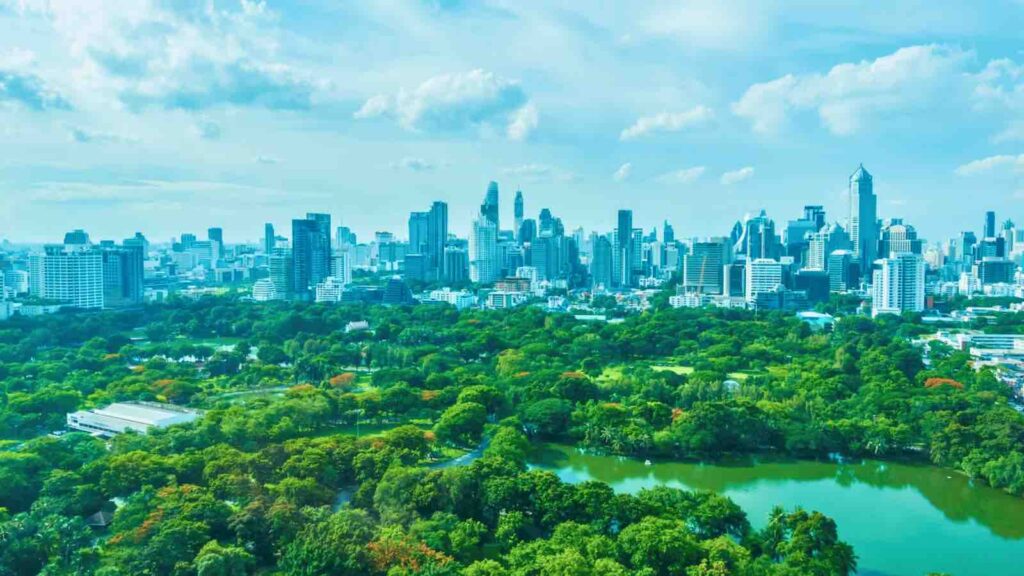The simple act of breathing clean air has become a distant dream for many, these comprehensive measures offer a roadmap for cities to reclaim and ensure this fundamental human right for their residents.
With the United Nations Human Rights Council heralding access to clean air as an inalienable human right, the onus squarely falls on cities to safeguard this entitlement for their denizens. Despite the apparent irony in stepping outdoors in a bustling metropolis to catch a breath of fresh air, urban planners are now tasked with turning this aspiration into reality.
RELEVANT SUSTAINABLE GOALS



Decoding the Perils of Air Pollution
Air pollution isn’t merely an environmental concern; it’s a pervasive threat that insidiously infiltrates the air we breathe, laden with deleterious chemical, physical, and biological agents. It’s emitted from myriad sources—vehicles, industrial units, power plants, household heating appliances, and even wildfires, contributing significantly to the greenhouse effect and, consequently, global warming.
Beyond its environmental toll, air pollution exacts a grim human cost, precipitating chronic diseases and claiming lives. According to the World Health Organization (WHO), pollutants like particulate matter (PM), carbon monoxide, ozone, nitrogen dioxide, and sulfur dioxide are particularly perilous. In 2019, air pollution accounted for an alarming 6.7 million deaths globally. Notably, PM air pollution was implicated in 3.5 million premature deaths and years lost to cardiovascular disabilities.
Alarmingly, while 99% of the global populace is exposed to air quality that breaches WHO’s stringent guidelines, residents in low- and middle-income nations bear the brunt of its impact, with South Asia emerging as the most adversely affected region.
A Blueprint for Clean Urban Air
In the face of these stark realities, how can cities champion the right to clean air?
Strategic Data Collection & Monitoring
Adopting an evidence-centric approach is pivotal. Cities must leverage technological breakthroughs to install and integrate air quality sensors strategically across urban landscapes. These sensors, working in real-time, collate and analyze crucial air quality data, offering insights into exposure levels, pollutant types, hotspots, and temporal patterns.
Enforcing Robust Standards & Regulations
While local air quality thresholds often exceed WHO’s recommendations, cities must recalibrate these limits to prioritize public health over industrial interests. Implementing and rigorously monitoring these standards, coupled with astute zoning, is imperative, with public engagement in monitoring being a valuable asset.
Revitalizing Public Transportation
With motor vehicles being significant pollution contributors, cities should invest in developing and promoting accessible, affordable, and efficient public transit systems. Initiatives can include electrification of public buses and expanding inner-city rail networks, providing viable alternatives to personal vehicle use.
Embracing Green Urban Planning
Shifting the urban development paradigm from vehicle-centric to people-focused is crucial. Infrastructure like walkways, bicycle lanes, and bridges not only promotes active living but also curtails pollution. Furthermore, green public spaces offer residents pockets of tranquility and well-being, fostering community interactions and potentially bolstering local economies.
Securing Funding & Fostering Collaborations
Executing these initiatives necessitates substantial funding and strategic collaborations. Clear, actionable plans can attract investment, as evidenced by South Korea’s success in securing funding for its anti-pollution strategies from 2005 to 2020. Collaborative platforms like Breathe Cities — a $30 million initiative by Bloomberg Philanthropies, Clean Air Fund, and C40 Cities — offer cities financial, technical, and advisory support. Engaging the private sector in financing efforts to ensure clean air for all is also a viable and necessary strategy.
Towards a Future of Clean, Breathable Air
In a world where the simple act of breathing clean air has become a distant dream for many, these comprehensive measures offer a roadmap for cities to reclaim and ensure this fundamental human right for their residents. Through informed planning, stringent regulation, and collaborative action, the vision of urban areas that nurture rather than negate our right to clean air is not just achievable, but imperative.
Lead image courtesy of Mrsiraphol via Freepik
You may also be interested in :
The Looming Air Quality Crisis : Over 6.5 Million Deaths Annually, Asia-Pacific At The Epicentre



